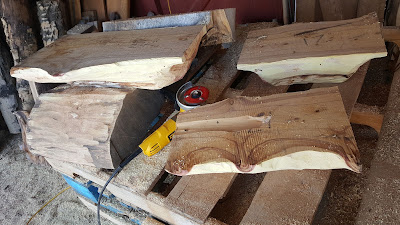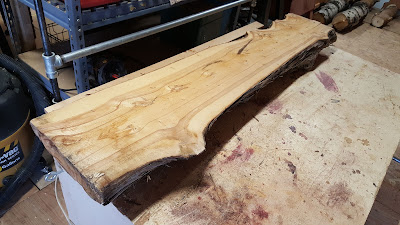What an absolutely gorgeous day today! Warm temps, little to no breeze, sunny skies. It really doesn't get any better than this to make some serious sawdust, especially outside!
After cutting three bowl blanks from the juniper log featured in my last post, the work of carving and shaping began.
The tool I use to get the bark off (usually juniper bark falls off after being exposed to the elements for a time....this bark was still attached) is my angle grinder with a very aggressive carving and shaping disc tool. I don't really care for this carving and shaping disc tool because it is too aggressive for my liking. The carbide teeth grab and pull if the user isn't super vigilant, and vibration is a real issue when it comes to physical fatigue using it. When it wears out, my next one will have more than the three teeth seen in the photo for sure!
Setup for doing this kind of work is a snap with the two logs on top of some pallets I now use to semi secure the log blank I'm working on. Someone somewhere suggested using sandbags for this purpose, but I'm finding debarked logs work very well, too, and that's what I went with.
Once the bark was removed, some of the yellow sapwood also had to be ground off. The photo below shows all three bowl blanks with almost all the bark removed along with some of the sapwood. The ends getting ground down to a rough shape was also part of this process.
Flipping them over revealed the bottoms needed to be planed down at least another inch in order for the bowls to be stable and not tip over while in use. That step happens this afternoon....I'm on break for a bit!
Break time is OVER!
I originally thought taking off one inch, or so, would do it, but ended up taking off almost two inches in order to get them as stable as they need to be.
I've said it before, and I'll say it again.....the router planer in the photo above is one of the best tools in my shop, especially for working on irregular shape pieces.
In this instance, though, I was lucky because the slab was flat on the side that's eventually going to get hogged out (bandsaw sawmill). That made securing the piece really easy.
So, in order to secure the piece, I used deck screws through a scrap 2x6 I had laying around. First, I secured the 2x6 to the piece on the part that will eventually get hogged out with one screw. That way, it didn't matter if there was a hole from the screw because that would get carved out anyway. The 2x6 was then secured to the work surface with two screws, one on each end of the 2x6. The piece was now nice and secure.
From there, it was a matter of taking off as much as needed to make the piece sit solid on a flat surface when done (the one on the left in the photo below).
To get a similar height on the next piece, all I did was place that piece (the one on the right in the photo above) to be done upside down next to the completed piece, and scribe a mark at about the same height that will be the limit to how much I'll take off with the router planer.
From there, I did the same thing with the third, and largest, piece, and now I have three bowl blanks that I'll be hogging out tomorrow, weather and my own physical aches and pains permitting.
Methinks these are gonna be some really nice bowls!!!
DWR

















































